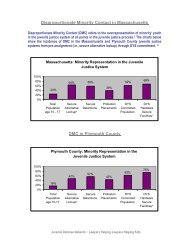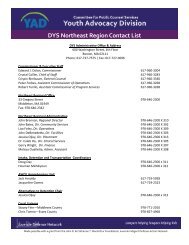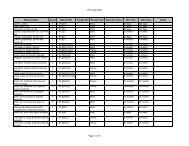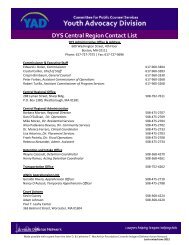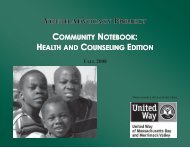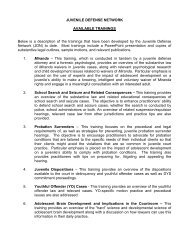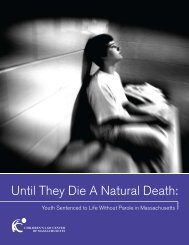States rethink 'adult time for adult crime' - the Youth Advocacy Division
States rethink 'adult time for adult crime' - the Youth Advocacy Division
States rethink 'adult time for adult crime' - the Youth Advocacy Division
Create successful ePaper yourself
Turn your PDF publications into a flip-book with our unique Google optimized e-Paper software.
What Makes Teens Tick; A flood of hormones, sure. But also a host of struct...plain <strong>the</strong> behaviors that make adolescence so exciting--and so exasperating<br />
disorders. Some scientists now believe that ADHD and Tourette's syndrome, which<br />
typically appear by <strong>the</strong> <strong>time</strong> a child reaches age 7, may be related to <strong>the</strong> brain<br />
proliferation period. Though both disorders have genetic roots, <strong>the</strong> rapid growth of<br />
brain tissue in early childhood, especially in regions rich in dopamine, "may set <strong>the</strong><br />
stage <strong>for</strong> <strong>the</strong> increase in motor activities and tics," says Dr. Martin Teicher, director<br />
of developmental biopsychiatry research at McLean Hospital. "When it starts to<br />
prune in adolescence, you often see symptoms recede."<br />
Schizophrenia, on <strong>the</strong> o<strong>the</strong>r hand, makes its appearance at about <strong>the</strong> <strong>time</strong> <strong>the</strong><br />
prefrontal cortex is getting pruned. "Many people have speculated that schizophrenia<br />
may be due to an abnormality in <strong>the</strong> pruning process," says Teicher. "Ano<strong>the</strong>r<br />
hypo<strong>the</strong>sis is that schizophrenia has a much earlier, prenatal origin, but as <strong>the</strong> brain<br />
prunes, it gets unmasked." MRI studies have shown that while <strong>the</strong> average teenager<br />
loses about 15% of his cortical gray matter, those who develop schizophrenia lose as<br />
much as 25%.<br />
WHAT'S A PARENT TO DO<br />
Brain scientists tend to be reluctant to make <strong>the</strong> leap from <strong>the</strong> laboratory to real-life,<br />
hard-core teenagers. Some feel a little burned by <strong>the</strong> way earlier neurological<br />
discoveries resulted in Baby Einstein tapes and o<strong>the</strong>r marketing schemes that<br />
misapplied <strong>the</strong>ir science. It is clear, however, that <strong>the</strong>re are implications in <strong>the</strong> new<br />
research <strong>for</strong> parents, educators and lawmakers.<br />
In light of what has been learned, it seems almost arbitrary that our society has<br />
decided that a young American is ready to drive a car at 16, to vote and serve in <strong>the</strong><br />
Army at 18 and to drink alcohol at 21. Giedd says <strong>the</strong> best estimate <strong>for</strong> when <strong>the</strong><br />
brain is truly mature is 25, <strong>the</strong> age at which you can rent a car. "Avis must have<br />
some pretty sophisticated neuroscientists," he jokes. Now that we have scientific<br />
evidence that <strong>the</strong> adolescent brain is not quite up to scratch, some legal scholars<br />
and child advocates argue that minors should never be tried as <strong>adult</strong>s and should be<br />
spared <strong>the</strong> death penalty. Last year, in an official statement that summarized<br />
current research on <strong>the</strong> adolescent brain, <strong>the</strong> American Bar Association urged all<br />
state legislatures to ban <strong>the</strong> death penalty <strong>for</strong> juveniles. "For social and biological<br />
reasons," it read, "teens have increased difficulty making mature decisions and<br />
understanding <strong>the</strong> consequences of <strong>the</strong>ir actions."<br />
Most parents, of course, know this instinctively. Still, it's useful to learn that teenage<br />
behavior is not just a matter of willful pigheadedness or determination to drive you<br />
crazy--though <strong>the</strong>se, too, can be factors. "There's a debate over how much<br />
conscious control kids have," says Giedd, who has four "teenagers in training" of his<br />
own. "You can tell <strong>the</strong>m to shape up or ship out, but making mistakes is part of how<br />
<strong>the</strong> brain optimally grows." It might be more useful to help <strong>the</strong>m make up <strong>for</strong> what<br />
<strong>the</strong>ir brain still lacks by providing structure, organizing <strong>the</strong>ir <strong>time</strong>, guiding <strong>the</strong>m<br />
through tough decisions (even when <strong>the</strong>y resist) and applying those <strong>time</strong>-tested<br />
parental virtues: patience and love.<br />
--With reporting by Alice Park/New York<br />
INSIDE THE ADOLESCENT BRAIN<br />
The brain undergoes two major developmental spurts, one in <strong>the</strong> womb and <strong>the</strong><br />
second from childhood through <strong>the</strong> teen years, when <strong>the</strong> organ matures by fits and<br />
starts in a sequence that moves from <strong>the</strong> back of <strong>the</strong> brain to <strong>the</strong> front<br />
BRAIN AREA<br />
DESCRIPTION / DUTIES<br />
file:///L|/JDN/Brain%20Resources/Brain%20Developmen...iling%20Packet/8.%20What%20Makes%20Teens%20Tick.htm (6 of 8)8/16/2006 4:44:18 PM





